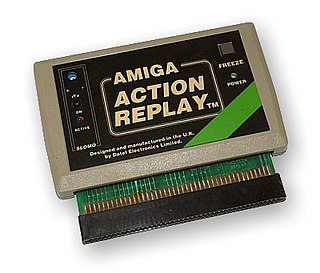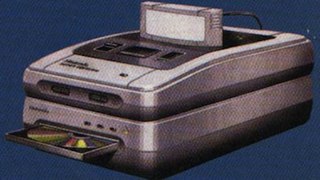
The Nintendo 64 (N64) is a home video game console developed by Nintendo. It was released on June 23, 1996, in Japan; on September 29, 1996, in North America; and on March 1, 1997, in Europe and Australia. The successor to the Super Nintendo Entertainment System, it was the last major home console to use cartridges as its primary storage format until the Nintendo Switch in 2017. It competed primarily with the Sony PlayStation and the Sega Saturn.

The 64DD is a magnetic floppy disk drive peripheral for the Nintendo 64 game console developed by Nintendo. It was announced in 1995, prior to the Nintendo 64's 1996 launch, and after numerous delays was released in Japan on December 13, 1999. The "64" references both the Nintendo 64 console and the 64MB storage capacity of the disks, and "DD" is short for "disk drive" or "dynamic drive".
Game Genie is a line of video game cheat cartridges originally designed by Codemasters, sold by Camerica and Galoob. The first device in the series was released in 1990 for the Nintendo Entertainment System, with subsequent devices released for the Super NES, Game Boy, Genesis, and Game Gear. All Game Genie devices temporarily modify game data, allowing the player to do things unintended by developers such as, depending on the game, cheating, manipulating various aspects of games, and accessing unused assets and functions. Five million units of the original Game Genie products were sold worldwide, and most video game console emulators for the platforms it was on feature Game Genie code support. Emulators that have Game Genie support also allow a near-unlimited number of codes to be entered whereas the actual products have an upper and lower limit, between three and six codes.
A regional lockout is a class of digital rights management preventing the use of a certain product or service, such as multimedia or a hardware device, outside a certain region or territory. A regional lockout may be enforced through physical means, through technological means such as detecting the user's IP address or using an identifying code, or through unintentional means introduced by devices only supporting certain regional technologies.

Bung Enterprises Ltd. was an electronics company based in Hong Kong. Its products were controversial backup and development units for videogame consoles, which could allow the user to play a game without owning the original cartridge. Backup units for Nintendo Entertainment System, Super NES, Neo-Geo, Neo Geo Pocket, Genesis, Game Boy and Nintendo 64 were developed and produced by Bung.

The Super Game Boy is a peripheral that allows Game Boy cartridges to be played on a Super Nintendo Entertainment System console. Released in June 1994, it retailed for $59.99 in the United States and £49.99 in the United Kingdom. In South Korea, it is called the Super Mini Comboy and was distributed by Hyundai Electronics. A revised model, the Super Game Boy 2, was released in Japan in January 1998.

A ROM image, or ROM file, is a computer file which contains a copy of the data from a read-only memory chip, often from a video game cartridge, or used to contain a computer's firmware, or from an arcade game's main board. The term is frequently used in the context of emulation, whereby older games or firmware are copied to ROM files on modern computers and can, using a piece of software known as an emulator, be run on a different device than which they were designed for. ROM burners are used to copy ROM images to hardware, such as ROM cartridges, or ROM chips, for debugging and QA testing.

Action Replay is the brand name of a cheating device created by Datel. The Action Replay is available for many gaming systems including the Nintendo DS, Nintendo DSi, Nintendo 3DS, PlayStation Portable, PlayStation 2, GameCube, Game Boy Advance, and the Xbox. The name is derived from the first devices’ signature ability to pause the execution of the software and save the computer's state to disk or tape for future “replay”. The ability to manipulate the contents of memory in this paused state permitted the cheat functions for which the brand is now better known.
Homebrew, when applied to video games, refers to software produced by hobbyists for proprietary video game consoles which are not intended to be user-programmable. The official documentation is often only available to licensed developers, and these systems may use storage formats that make distribution difficult, such as ROM cartridges or encrypted CD-ROMs. Many consoles have hardware restrictions to prevent unauthorized development.

Nintendo Power was a video game distribution service for Super Famicom or Game Boy operated by Nintendo that ran exclusively in Japan from late 1996 until February 2007. The service allowed users to download Super Famicom or Game Boy titles onto a special flash memory cartridge for a lower price than that of a pre-written ROM cartridge.

The CD64 is a game backup device made by UFO/Success Company for the Nintendo 64 that allows users to run ROM files off a CD-ROM attached to the system. Similar to the Doctor V64 and the Z64 units for the N64, it is most commonly used for playing backups of Nintendo 64 games. Since it has a built-in communications port that is accessible from the N64 program, it can also be used as a rather versatile development/debug device.
This is a list of video game accessories that have been released for the Game Boy handheld console and its successors. Accessories add functionality that the console would otherwise not have.

A ROM cartridge, usually referred to in context simply as a cartridge, cart, or card, is a replaceable part designed to be connected to a consumer electronics device such as a home computer, video game console or, to a lesser extent, electronic musical instruments.
Nintendo 64 accessories are first-party Nintendo hardware—and third-party hardware, licensed and unlicensed. Nintendo's first-party accessories are mainly transformative system expansions: the 64DD Internet multimedia platform, with a floppy drive, video capture and editor, game building setup, web browser, and online service; the controller plus its own expansions for storage and rumble feedback; and the RAM-boosting Expansion Pak for big improvements in graphics and gameplay. Third-party accessories include the essential game developer tools built by SGI and SN Systems on Nintendo's behalf, an unlicensed SharkWire online service, and unlicensed cheaper counterparts to first-party items. In the fifth generation of video game consoles, the Nintendo 64 had a market lifespan from 1996 to 2002.

A game backup device, informally called a copier, is a device for backing up ROM data from a video game cartridge to a computer file called a ROM image and playing them back on the official hardware. Recently flash cartridges, especially on the Game Boy Advance and Nintendo DS platforms, only support the latter function; they cannot be used for backing up ROM data. Game backup devices also make it possible to develop homebrew software on video game systems. Game backup devices differ from modchips in that modchips are used in conjunction with systems that use generally available media such as CDs and DVDs, whereas game backup devices are used with systems that use cartridges.

The Super NES CD-ROM is an unreleased add-on for the Super Nintendo Entertainment System (SNES) video game console. It was built upon the functionality of the cartridge-based SNES by adding support for a CD-ROM-based format known as Super Disc.

RAM pack, RAMpack, RAM expansion cartridge, RAM expansion unit (REU), memory expansion pak and memory module are some of the most common names given to various self-contained units or cartridges that expand a computer, games console or other device's own internal RAM in a user-friendly manner.

Nintendo 64 Game Pak is the brand name of the ROM cartridges that store game data for the Nintendo 64. As with Nintendo's previous consoles, the Game Pak's design strategy was intended to achieve maximal read speed and lower console manufacturing costs through not integrating a mechanical drive, with a drawback of lower per dollar storage capacity compared to a disk. From the console's first year from late 1996 through 1997, Game Pak sizes were 4 to 12 megabytes with a typical third party retail price of US$75.99, then available in 32 megabytes in 1998, and finally 64 megabytes from 1999 onwards.
Game development kits (GDK) are specialized hardware and software used to create commercial video games for game consoles. They may be partnered with game development tools, special game engine licenses, and other middleware to aid video game development. GDKs are typically not available to the public, and require game developers to enter an agreement, partnership, or program with the hardware manufacturer to gain access to the hardware. As console generations pass, development kits often get sold through websites like eBay without repercussions. This is often because the console manufacturers discontinue certain development programs as time passes.













